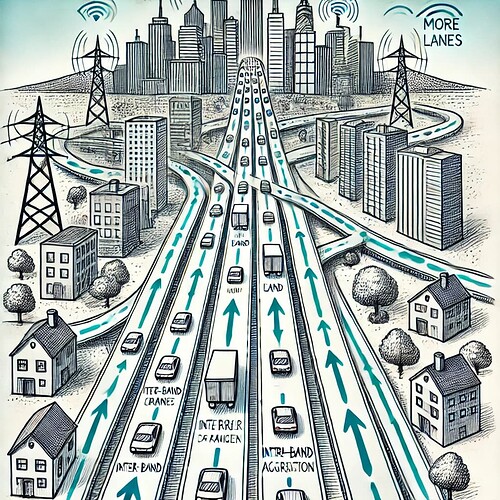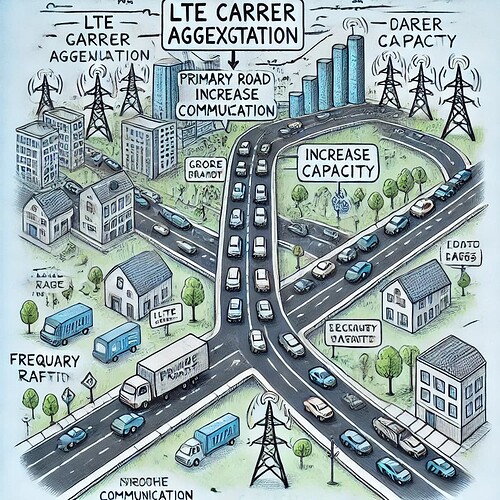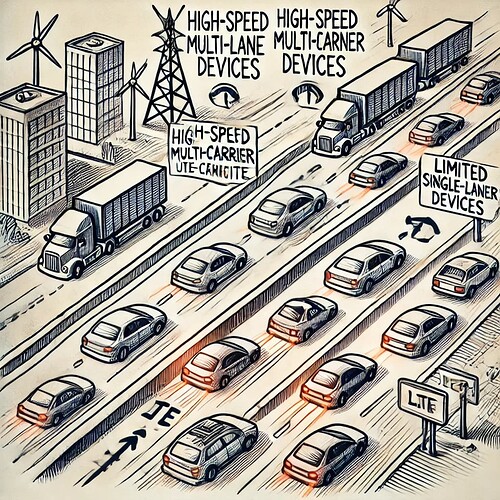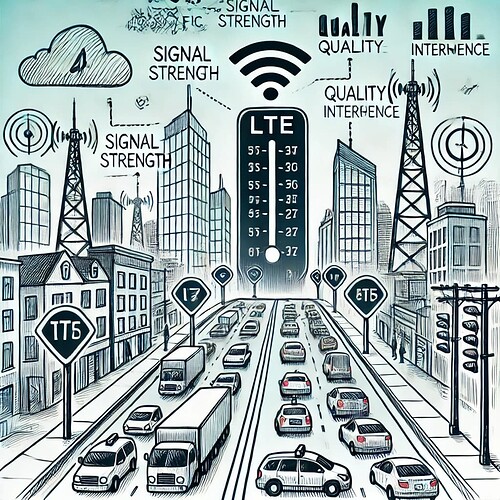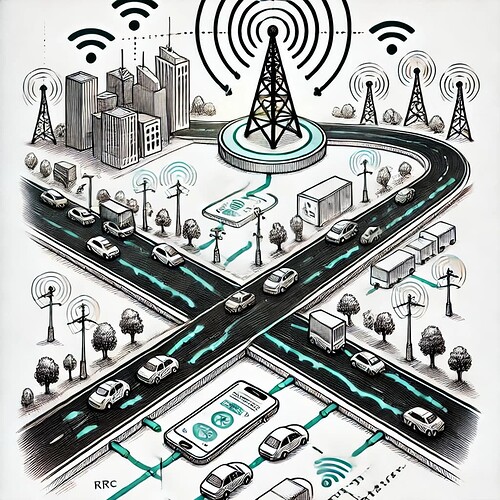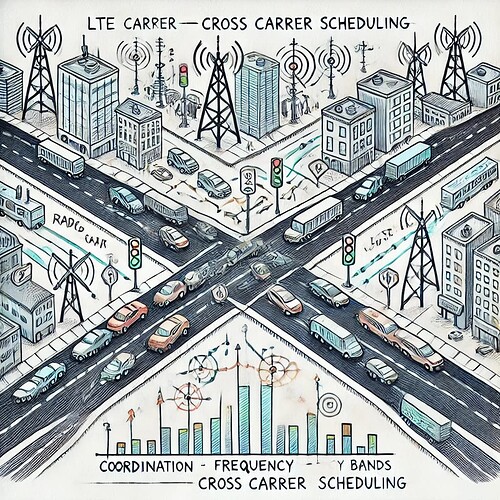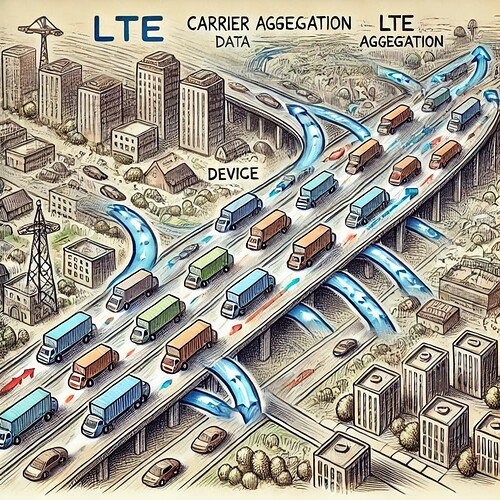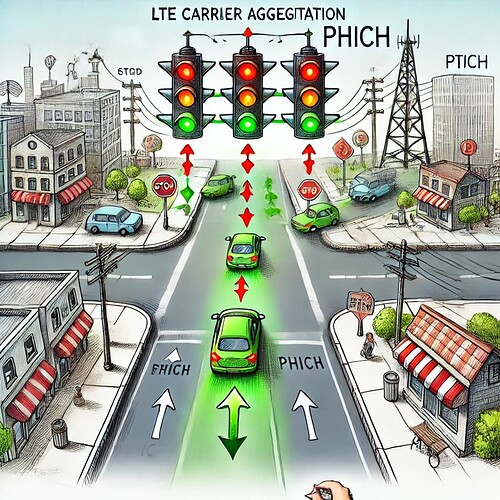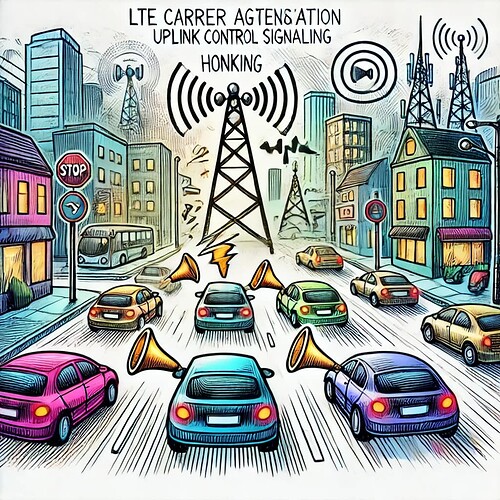This topic presents in a very simplified way all the main concepts that should be understood by those who know LTE.
LTE Carrier Aggregation
LTE Carrier Aggregation is a technology that allows the network to combine multiple frequency bands (or carriers) into a single, larger channel to boost data speeds and capacity. Instead of relying on just one road for data, Carrier Aggregation merges several smaller roads into a wider highway, allowing more data to travel at once. This improves the overall efficiency and speed of the network. It can be used within the same frequency band (Intra-Band) or across different bands (Inter-Band), depending on what’s available. Carrier Aggregation helps provide faster downloads, better coverage, and a smoother overall experience for users.
![]() Carrier Aggregation in LTE is like the city building a superhighway by combining several smaller roads into one large road. Instead of just using one street, the city connects multiple streets to create more lanes, allowing more cars (data) to travel at once. This helps reduce traffic jams and speeds up the flow of cars to their destinations. Whether the city adds more lanes to the same road (Intra-Band) or connects roads from different parts of the city (Inter-Band), it ensures everyone gets to their destination faster and more efficiently.
Carrier Aggregation in LTE is like the city building a superhighway by combining several smaller roads into one large road. Instead of just using one street, the city connects multiple streets to create more lanes, allowing more cars (data) to travel at once. This helps reduce traffic jams and speeds up the flow of cars to their destinations. Whether the city adds more lanes to the same road (Intra-Band) or connects roads from different parts of the city (Inter-Band), it ensures everyone gets to their destination faster and more efficiently.
Skip to: Roadmap to LTE
- Carrier Aggregation Introduction
- Carrier Organization
- Intra-Band Carrier Aggregation
- Inter-Band Carrier Aggregation
- UE Capability
- Measurements
- Uplink Power Control
- RRC Signaling
- Cross Carrier Scheduling
- Fast Activation and Deactivation
- Data Flow
- PHICH
- Uplink Control Signaling
Carrier Aggregation Introduction
Carrier Aggregation in LTE combines multiple frequency bands (carriers) to create a bigger “pipe” for data, allowing faster speeds and more efficient data transmission. It allow the network to use multiple frequency bands together, helping the network use available resources more effectively,
![]() Carrier Aggregation is like adding more roads to the city—combining multiple smaller roads into a superhighway. It helps data (cars) travel faster by combining several lanes into one highway, speeding up traffic and allowing more data to move at once. It’s like combining several small roads to create a superhighway, so data travels faster and more smoothly by using multiple paths at once.
Carrier Aggregation is like adding more roads to the city—combining multiple smaller roads into a superhighway. It helps data (cars) travel faster by combining several lanes into one highway, speeding up traffic and allowing more data to move at once. It’s like combining several small roads to create a superhighway, so data travels faster and more smoothly by using multiple paths at once.
- Search Forum
 LTE Carrier Aggregation Introduction
LTE Carrier Aggregation Introduction 
Carrier Organization
In LTE Carrier Aggregation, different frequency bands are organized into primary and secondary carriers. The primary carrier manages the core communication, while secondary carriers help increase data capacity when needed. It is how the carriers (or frequency bands) are structured and managed within the network.
![]() In the city, roads are organized into primary roads (main roads) and secondary roads (side streets). The primary road handles most of the traffic, and the secondary roads help by taking on extra cars when needed. Just like how the city plans and manages these superhighways, it ensures each road (or carrier) is used in the best way to keep the traffic flowing smoothly, organizing different lanes on a highway to ensure smooth traffic flow, with each lane dedicated to specific types of data traffic.
In the city, roads are organized into primary roads (main roads) and secondary roads (side streets). The primary road handles most of the traffic, and the secondary roads help by taking on extra cars when needed. Just like how the city plans and manages these superhighways, it ensures each road (or carrier) is used in the best way to keep the traffic flowing smoothly, organizing different lanes on a highway to ensure smooth traffic flow, with each lane dedicated to specific types of data traffic.
- Search Forum
 LTE Carrier Aggregation Organization
LTE Carrier Aggregation Organization 
Intra-Band Carrier Aggregation
Intra-Band Carrier Aggregation refers to combining multiple frequency bands within the same frequency range. This increases the available bandwidth for faster data speeds but keeps all the communication within a similar range.
![]() This is like adding more lanes to the same highway in the city. You’re making the same road wider, allowing more cars to travel side by side on the same path. It’s like expanding an existing road by adding more lanes. With these additional lanes, more cars (data) can travel at the same time, reducing the chances of traffic jams.
This is like adding more lanes to the same highway in the city. You’re making the same road wider, allowing more cars to travel side by side on the same path. It’s like expanding an existing road by adding more lanes. With these additional lanes, more cars (data) can travel at the same time, reducing the chances of traffic jams.
- Search Forum
 LTE Intra-Band Carrier Aggregation
LTE Intra-Band Carrier Aggregation 
Inter-Band Carrier Aggregation
Inter-Band Carrier Aggregation combines frequency bands from different ranges. This helps the network utilize different parts of the spectrum, improving overall capacity by spreading data across multiple bands.
![]() Inter-Band Carrier Aggregation is like opening up new highways in different parts of the city, not just expanding one. It spreads the traffic across multiple roads in different areas, helping the city manage even more data. It’s like connecting different highways together, combining roads from various parts of the city to ensure cars (data) can travel on the best paths available and reach their destination quickly.
Inter-Band Carrier Aggregation is like opening up new highways in different parts of the city, not just expanding one. It spreads the traffic across multiple roads in different areas, helping the city manage even more data. It’s like connecting different highways together, combining roads from various parts of the city to ensure cars (data) can travel on the best paths available and reach their destination quickly.
- Search Forum
 LTE Inter-Band Carrier Aggregation
LTE Inter-Band Carrier Aggregation 
UE Capability
UE Capability refers to the device’s ability to support Carrier Aggregation. Different devices can handle varying numbers of carriers, which affects the data speeds they can achieve. More advanced devices can connect to more carriers for faster performance. It refers to the device’s ability to handle Carrier Aggregation.
![]() Every car in the city (device) has different capabilities. Some cars can drive on all types of roads, while others can only use certain highways. UE Capability is like knowing how many roads your car can handle at once. It’s about making sure your car is ready to drive on these new superhighways, checking if it can handle the speed and multiple lanes to travel efficiently. It’s like ensuring your car is capable of driving on multi-lane highways and various interconnected roads to maximize speed and efficiency.
Every car in the city (device) has different capabilities. Some cars can drive on all types of roads, while others can only use certain highways. UE Capability is like knowing how many roads your car can handle at once. It’s about making sure your car is ready to drive on these new superhighways, checking if it can handle the speed and multiple lanes to travel efficiently. It’s like ensuring your car is capable of driving on multi-lane highways and various interconnected roads to maximize speed and efficiency.
- Search Forum
 LTE Carrier Aggregation UE Capability
LTE Carrier Aggregation UE Capability 
Measurements
Measurements in LTE Carrier Aggregation help the network assess signal strength, quality, and other parameters to optimize network performance and make decisions about which carriers to use for the best connection. The network measures things like signal strength and interference to manage the traffic efficiently.
![]() Just like the city checks road conditions, the network measures how well the roads (channels) are performing. It keeps track of traffic (data flow) and ensures everything is moving smoothly. It’s like traffic monitors that check road conditions, telling the city how well the roads are functioning and helping to make adjustments to keep traffic flowing smoothly.
Just like the city checks road conditions, the network measures how well the roads (channels) are performing. It keeps track of traffic (data flow) and ensures everything is moving smoothly. It’s like traffic monitors that check road conditions, telling the city how well the roads are functioning and helping to make adjustments to keep traffic flowing smoothly.
- Search Forum
 LTE Carrier Aggregation Measurements
LTE Carrier Aggregation Measurements 
Uplink Power Control
Uplink Power Control is the mechanism by which the device adjusts its transmission power when sending data to the network to ensure it can communicate effectively with the network. This helps avoid interference and maintain a good connection, especially in Carrier Aggregation scenarios.
![]() Imagine cars in the city adjusting their speed based on traffic and road conditions. Uplink Power Control is like your phone adjusting how much power it uses to send messages, ensuring safe and efficient communication without wasting energy. It ensures you drive at the right speed to avoid causing traffic jams or delays, helping keep everything moving smoothly.
Imagine cars in the city adjusting their speed based on traffic and road conditions. Uplink Power Control is like your phone adjusting how much power it uses to send messages, ensuring safe and efficient communication without wasting energy. It ensures you drive at the right speed to avoid causing traffic jams or delays, helping keep everything moving smoothly.
- Search Forum
 LTE Carrier Aggregation Uplink Power Control
LTE Carrier Aggregation Uplink Power Control 
RRC Signaling
RRC (Radio Resource Control) Signaling is the communication between the device and the network that manages how resources are allocated. It helps the network manage Carrier Aggregation by telling the device which carriers to use and when to switch between them.
![]() RRC Signaling is like the city’s communication system for organizing traffic. It tells your car when and where it can enter the roads and how many lanes it should use to ensure smooth traffic flow. It’s like the city’s traffic control system, managing and directing cars to the best routes, ensuring that everyone reaches their destination without delays.
RRC Signaling is like the city’s communication system for organizing traffic. It tells your car when and where it can enter the roads and how many lanes it should use to ensure smooth traffic flow. It’s like the city’s traffic control system, managing and directing cars to the best routes, ensuring that everyone reaches their destination without delays.
- Search Forum
 LTE Carrier Aggregation RRC Signaling
LTE Carrier Aggregation RRC Signaling 
Cross Carrier Scheduling
Cross Carrier Scheduling allows the network to schedule resources across multiple different carriers. This means the network can coordinate data transmission across different frequency bands, improving efficiency and ensuring smooth communication.
![]() This is like the city deciding which road your car should take to reach its destination quickly. The network decides which lanes to use to keep all the cars moving efficiently across the different roads (carriers). It’s like having multiple traffic control centers working together to manage the flow of cars across various highways, ensuring that data is sent along the best paths available.
This is like the city deciding which road your car should take to reach its destination quickly. The network decides which lanes to use to keep all the cars moving efficiently across the different roads (carriers). It’s like having multiple traffic control centers working together to manage the flow of cars across various highways, ensuring that data is sent along the best paths available.
- Search Forum
 LTE Carrier Aggregation Cross Carrier Scheduling
LTE Carrier Aggregation Cross Carrier Scheduling 
Fast Activation and Deactivation
Fast Activation and Deactivation enable the network to quickly turn additional carriers on or off based on traffic demand. This flexibility ensures efficient use of resources without wasting bandwidth when it’s not needed. This feature allows the network to quickly activate or deactivate carriers as needed, based on data demand.
![]() Fast Activation and Deactivation is like the city quickly opening or closing lanes during rush hour. If traffic gets heavy, more lanes are opened to keep things moving smoothly, and when traffic lightens, they’re closed. This allows the network to quickly adjust, opening more lanes when there’s a lot of traffic and closing them when they’re not needed.
Fast Activation and Deactivation is like the city quickly opening or closing lanes during rush hour. If traffic gets heavy, more lanes are opened to keep things moving smoothly, and when traffic lightens, they’re closed. This allows the network to quickly adjust, opening more lanes when there’s a lot of traffic and closing them when they’re not needed.
Data Flow
Data Flow refers to the continuous transmission of data between the device and the network. With Carrier Aggregation, the flow of data can be split across multiple carriers, resulting in faster speeds and better performance. It is how data moves through the combined carriers.
![]() Data Flow is like the movement of cars traveling from one part of the city to another. The smoother the roads, the faster the data can travel from your device to the network and back. It’s like monitoring how cars move on the highways, showing how smoothly and quickly the cars (data) are flowing through the city, ensuring everyone reaches their destination efficiently.
Data Flow is like the movement of cars traveling from one part of the city to another. The smoother the roads, the faster the data can travel from your device to the network and back. It’s like monitoring how cars move on the highways, showing how smoothly and quickly the cars (data) are flowing through the city, ensuring everyone reaches their destination efficiently.
- Search Forum
 LTE Carrier Aggregation Data Flow
LTE Carrier Aggregation Data Flow 
PHICH
PHICH is a feedback channel that lets the device know whether its data has been successfully received by the network. If something goes wrong, PHICH signals the device to resend the data. It is used for error correction in data transmission.
![]() PHICH is like the traffic lights in the city. It signals whether your car (data) made it through an intersection safely. If there’s a problem, the light tells the car to go back and try again, ensuring there are no crashes or missed messages. It’s like road signs that give feedback to drivers (your device), letting them know if they need to resend data or if it was received correctly.
PHICH is like the traffic lights in the city. It signals whether your car (data) made it through an intersection safely. If there’s a problem, the light tells the car to go back and try again, ensuring there are no crashes or missed messages. It’s like road signs that give feedback to drivers (your device), letting them know if they need to resend data or if it was received correctly.
- Search Forum
 LTE Carrier Aggregation PHICH
LTE Carrier Aggregation PHICH 
Uplink Control Signaling
Uplink Control Signaling is the communication from the device to the network, sending important feedback like signal quality or scheduling requests. It helps the network manage data transmission and optimize performance.
![]() Uplink Control Signaling is like honking your horn to let the city know you’re there. Your phone sends signals to the network, asking for directions, checking road conditions, and making sure everything stays organized while it sends data. It’s like a driver signaling their intentions, such as turning or stopping, ensuring smooth communication and coordination with other cars (data transmissions).
Uplink Control Signaling is like honking your horn to let the city know you’re there. Your phone sends signals to the network, asking for directions, checking road conditions, and making sure everything stays organized while it sends data. It’s like a driver signaling their intentions, such as turning or stopping, ensuring smooth communication and coordination with other cars (data transmissions).
- Search Forum
 LTE Carrier Aggregation Uplink Control Signaling
LTE Carrier Aggregation Uplink Control Signaling 
That’s it. ![]()
-
Continue reading: Roadmap to LTE - UE Capabilities
-
Or back to: Roadmap to LTE
